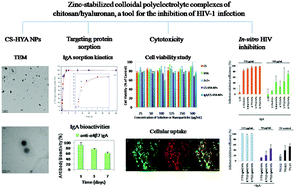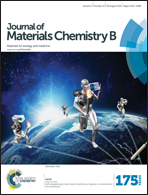Zinc-stabilized colloidal polyelectrolyte complexes of chitosan/hyaluronan: a tool for the inhibition of HIV-1 infection†
Abstract
Zinc(II) stabilized polyelectrolyte nano-complexes (PECs) of chitosan and hyaluronan (HYA) were designed as safe and efficient drug delivery systems. HIV-1 reverse transcriptase inhibitor tenofovir (TF) was quantitatively encapsulated and the particle interface could be functionalized in PBS with targeting proteins such as anti-α4β7 immunoglobulin A. Chitosan–HYA nanoPECs were non-cytotoxic on human peripheral blood mononuclear cells (PBMCs), within the investigated nanoparticle concentrations. A dose-dependent reduction of the HIV-1 infection of PBMCs co-cultured with the nanocarriers was observed. Even more interestingly, a synergistic effect was evidenced with the nanocarriers by comparing the IC50 (50% inhibitory concentration) value of the aqueous TF solution (4.35 μmol L−1) with that of TF loaded nanoPECs (1.71 μmol L−1) and anti-α4β7 IgA functionalized TF/nanoPECs (1.01 μmol L−1). This effect could be attributed to the presence of zinc(II) in the formulation of the colloids. All these data establish that the zinc(II) stabilized chitosan–HYA nanoPECs can be potentially efficient and safe colloidal delivery system candidates for enhancing antiviral activities in the treatment of HIV infection and AIDS.


 Please wait while we load your content...
Please wait while we load your content...